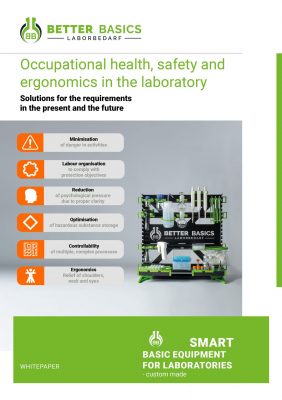| DIN EN 13150-2001 DE Work tables for laboratories – dimensions, safety requirements and test methods | TRGS-526 /TRGS 500 Technical Rules for hazardous substances protective measures |
| DIN EN 14056-2003 DE Laboratory equipment – recommendations for arrangement and assembly | GUV-I 850-0 Safe working in laboratories Basics and practical guide |
The SmartRack® and the innovative solutions of the SmartIntegrate product line - occupational safety and ergonomics
The world‘s only laboratory organisation system as your guarantor for safety and ergonomics in the laboratory workplace
Safety in laboratories is mainly determined by their structural environment, the equipment used and the qualifications of the laboratory staff.
- Risks for employees must be excluded in any case – the SmartRack® and the innovative solutions of the SmartIntegrate product line make an important contribution here.
- By combining technical as well as organisational measures, these dangers are significantly minimised – the SmartRack® and the innovative solutions of the SmartIntegrate product line are indispensable for this.
The SmartRack® and the innovative solutions of the SmartIntegrate product line meet all applicable specifications in the laboratory area according to DIN, DGUV and TRGS
Laboratory organisation system for employer and employee obligations
The SmartRack® and the innovative solutions of the SmartIntegrate product line – your optimal choice to meet all regulatory requirements.
Employers are obliged to organise their laboratory workplace in such a way that hazards are avoided, or at least kept to a minimum. (GUV-I 850-0 pt. 4.3.1) Requirements are also placed upon laboratory employees – it is their duty to keep their workplace in order as much as possible. The SmartRack® and the innovative solutions of the SmartIntegrate product line support both employers and employees in creating sufficiently safe and workplace-oriented storage space as well as storage facilities for laboratory glassware, for laboratory equipment, but also for samples and hazardous substances. Thanks to its adaptable module system and diverse, coordinated mounts and modules, the SmartRack® and the innovative solutions of the SmartIntegrate product line meet the requirements and secures the working environment in laboratories.
Solutions for the requirements of the present and the future
Occupational safety in the laboratory has always been a topic of enormous importance. Still, issues such as sharing laboratory resources, digitalisation in the laboratory, and laboratory automation are becoming increasingly important. Similarly, a new field of location-independent working is now emerging in the laboratory industry. In chemistry and biology laboratories, cost pressure and the need for more efficient use of existing workstation structures are growing. Before a laboratory workstation was permanently assigned to a laboratory technician and used over many years, today, it is used needs-oriented. It must be adapted to constantly changing tasks. Some universities and research institutes are leading the way and offer their resources for booking internally and across working groups. However, the most common reason for a shared economy in the laboratory sector is the potential for savings on high investment costs, which can be significantly reduced through better utilisation.
However, the age-appropriate design of workplaces is becoming just as important as it is relevant in the wake of the increasing shortage of skilled workers. Providing the technically optimal laboratory workstation for the respective activity with the best working conditions becomes a logistical challenge for a company, especially if sustainability criteria are to be considered. Laboratory companies will be faced with the challenge of balancing their employees’ performance and individual skill sets across all age groups and operational working conditions while remaining successful as a business. This balance is a new, albeit indirect, reason for making laboratory workplaces flexible and modular in design.
Solutions to all these questions are practically already available, just not in the combination necessary to answer this question. But what specific requirements will a laboratory workplace have to meet in 2022? Information on this is available in an entire series of guidelines and regulations, which are both recommendatory and binding.

Managing complex and interrelated hazards is extremely challenging for any human.
Dr. Marcus Heinze, Development Manager
The Standards at a Glance: DIN-EN, (D)GUV, TRGS
Information on this is available in a whole series of guidelines and regulations, which are both recommendatory and binding
- Those responsible for occupational health and safety will find what they are looking for in publication 213-850 of the German Social Accident Insurance (DGUV), which provides detailed information under the title “Working Safely in Laboratories – Basic Principles and Guidelines”.
- Also of great relevance are DIN EN 13150-2001 EN – Workbenches for laboratories – Safety requirements and test methods and
- DIN EN 14056-2003 EN – Laboratory furniture – Recommendations for design and installation,
- Technical rules for hazardous substances protective measures – TRGS 500
- Technical Rules for hazardous hubstances – TRGS 526 and
- the “Small Ergonomic Data Collection” of the Federal Institute for Occupational Safety and Health.
For companies in the field of laboratory equipment and laboratory organisation, the specification to be rendered analogously is thus critical: Safety and occupational health in laboratories are determined by the furnishings, equipment, construction, and procedures, as well as the apparatus and its operation, but also by the training and professional competence and proficiency of the laboratory staff. The aim is to reduce the risk to employees and the environment to a maximum by combining possible measures. Technical, organisational, and behavioural standards for employees serve this purpose. This task is precisely what the SmartRack® and the innovative solutions of the SmartIntegrate product line as laboratory organisation systems address because they essentially determine the activities that laboratory employees can perform and thus helps to reduce hazards.


But what does hazard reduction look like in the immediate environment of laboratory employees? In principle, work in the laboratory requires appropriate training, instruction, and qualification. Professional errors should be excluded in this way. As mentioned in the first paragraph, the shortage of skilled workers is also becoming increasingly pressing in the laboratory environment. To ensure maximum safety, organisational and technical measures must be taken to eliminate hazards. These arise primarily due to repetitive activities, high time pressure and comparatively high demands on employees’ ability to concentrate.
Although not consciously exerted directly by colleagues or supervisors, psychological pressure can also affect the work in the laboratory from the employees’ private environment and thus become a safety risk. It is essential to create a safe working environment for employees, even under hidden, difficult mental conditions, by taking precautionary measures and optimally designing the workplace. A laboratory organisation system such as SmartRack® or the innovative solutions of the SmartIntegrate product line address this point and optimises safety by helping avoid errors.

Optimum use of gripping space, reach space, stretching space through the SmartRack® and the innovative solutions of the SmartIntegrate product line
An ergonomic optimisation of the workplace helps to relieve the shoulders, eyes and heads of users of the SmartRack® and the innovative solutions of the SmartIntegrate product line. This is achieved because all the work equipment can be optimally placed in the field of vision and within reach of the users. Three areas of the direct working environment: the gripping area for direct access in front of the laboratory assistant, the reach area next to it – it can be reached by stretching the arm, the stretching area requires a short-term displacement of the body‘s centre of gravityThe more significant the number of laboratory employees becomes, the more numerous the interdependencies resulting from the individual work. If it were assumed that a laboratory technician only works alone in one room at a fume cupboard, then even in the event of a laboratory accident, the consequences would be manageable – both for the one laboratory employee’s health and the technical equipment of the laboratory.
However, suppose many employees work in one room at many safety fume cupboards or safety workbenches. In that case, the number of possible interdependencies multiplies in the event of an accident. Now laboratory managers are particularly challenged because they must be aware of all possible combinations of risks and counteract them preventively through organisational measures. Managing complex and interrelated hazards is exceptionally challenging for any human. It is, therefore, essential to prevent this type of hazard association by taking organisational measures. If the storage of hazardous substances and handling of laboratory materials are simplified and structured, this helps keep these multiple risks under control.

If 200 employees can use 100 laboratory workstations, this saves money because high-quality and cost-intensive capital goods are also used optimally in laboratories in this way. However, this also goes hand in hand with the fact that workplaces must be changed frequently. On any given day, work can be done at a different lab workstation if needed. This additionally increases the pressure on concentration and the mental fitness of employees. Employers are, however, required to fully comply with the protection goals for their employees, even in the case of flexible use of workplaces. Saving capital equipment diametrically affects the achievability of protection goals. Despite the flexible workstation design, the SmartRack® and the innovative solutions of the SmartIntegrate product line enable mobile working under comparable conditions. Thanks to their transportability and modularity, the familiar and safe working environment can be quickly set up at any fume cupboard. This promotes safety through organisation and tidiness in the laboratory. The system also meets the requirements of TRGS 500 regarding tidiness and cleanliness measures by enabling well-structured storage of work equipment, laboratory glassware and hazardous substances.
Laboratory employees in Germany are paid an average monthly salary of EUR 3,375. Of course, significantly higher wages are also possible and not unusual. If a SmartRack® or an innovative solutions of the SmartIntegrate product line prevent only one accident with a personal injury during its entire service life, e.g., due to the spilling of an acid, which would result in a downtime of at least two weeks, then costs of approx. 2,000 EUR were avoided by using the SmartRack® or one the innovative solutions of the SmartIntegrate product line – far more than the SmartRack® or the innovative solutions of the SmartIntegrate product line themself costs.

Ergonomic design of computer workstations for standing activities by using the SmartRack® and the innovative solutions of the SmartIntegrate product line
With an optimal inclination of the head of 15° during standing activities, a 90° angle to the screen surface should be maintained The SmartRack® and the innovative solutions of the SmartIntegrate product line also optimise the use of screens on laboratory work tables and on laboratory fume hoods. The optional tablet holder allows the individual adjustment of the viewing angle through the height positioning of the slot rails. Ergonomics for standing activities: When working, especially in the laboratory environment, the height of the worktable is usually not adjustable. Since it is important to ensure an optimal inclination of the head in relation to the work and/or the screens, only the SmartRack® and the innovative solutions of the SmartIntegrate product line with their tablet holder currently allow the optimal, ergonomic positioning of the screen.The controllability of unforeseen events and their prevention under the extended circumstance of the mutual influence of workplaces, especially with flexible use, presents laboratory managers and occupational health and safety officers with new tasks. Laboratory staff must have the training and professional development to meet these requirements.
Hazardous substances are commonly used in laboratories. Their correct safekeeping is a complex issue. According to TRGS 500, hazardous substances can only be kept in certain areas and in certain quantities. This is where the SmartRack® and the innovative solutions of the SmartIntegrate product line come in, offering special modules for the safe holding of hazardous substances. Height-adjustable slotted rails and the option of locking in accordance with the requirements of DIN EN 14056-2003 for flexible holders ensure safe storage. The flexible design of the SmartRack® and the innovative solutions of the SmartIntegrate product line also allow for custom positioning to meet the ergonomic requirements of people of different heights. This ensures that hazardous substances can be handled in a safe and compliant manner.
The SmartRack® and the innovative solutions of the SmartIntegrate product line meet the requirements of the DIN standard by allowing deliberate mechanical locking. By placing the individual modules in height-adjustable slotted rails, the SmartRack® and the innovative solutions of the SmartIntegrate product line ensure the safe keeping of consumables in the laboratory, including hazardous substances. This minimises the risk of misuse or improper handling of hazardous substances, as required by TRGS 500.
For example, specifications regarding the height of workstations must be observed, especially with the increasing digitalisation of the laboratory, which increasingly involves using displays. The laboratory benches’ measurements depend on the activity type and range from 720 mm for seated activities to 900 mm for standing activities. Of course, height-adjustable tables offer improved ergonomics when adapting to different body sizes.

In order to relieve the shoulders, the neck, but also the eyes of laboratory employees, the work area in front of the employees should be optimally structured.
Dr. Marcus Heinze, Development Manager
To relieve the shoulders, neck, and eyes of laboratory employees, the work area in front of the employees should be optimally structured. This work area is ergonomically divided into three areas. The gripping area for direct access in front of the lab technician, the reaching area adjoins it – it can be reached by stretching the arm, and the stretching area requires short-term shifting of the body’s centre of gravity and should only be used very rarely.
The SmartRack® and the innovative solutions of the SmartIntegrate product line as laboratory organisations, optimise the use and accessibility of all three areas in a form that can be individually tailored to the user. To enable the optimum forward head tilt of 15° for standing tasks and simultaneous viewing of a screen at 90° to the viewer’s eye, the screen height and tilt must be adjustable. Here again, a laboratory organisation systems such as the SmartRack® or the innovative solutions of the SmartIntegrate product line are an ideal tool, as they ensures that the exact position of the screen is made possible for each user thanks to the optional tablet holder in height-adjustable slot rails. There are also specifications of this type for sedentary activities.
For example, the optimum forward head tilt of 35° is to be maintained; the screen should be viewed at a 90° angle to the eye. Also, in this case, the ideal positioning of the screen can be ensured by using the SmartRack® or one of the innovative solutions of the SmartIntegrate product line employing adjustable modules.

Ergonomic design of computer workstations for sedentary work by using the SmartRack®and the innovative solutions of the SmartIntegrate product line
With an optimal inclination of the head of 35° during sedentary activities, a 90° angle to the screen surface should be maintained.
The use of screens at the laboratory workstation is also optimised by the SmartRack® and the innovative solutions of the SmartIntegrate product line. The optional tablet holder allows the individual adjustment of the viewing angle through the height positioning of the slot rails.
Ergonomics for sedentary work (left without, right with screen at the workplace): for sedentary work, it is important to ensure an optimal inclination of the head in relation the work on laboratory tables, laboratory fume hoods and/or screens
Summary: Occupational Safety in the Laboratory
Safety in the laboratory through technical means and optimal organisation alone is not conceivable and can only be implemented with the cooperation of laboratory employees.
They are also clearly required to cooperate in this way. Laboratory staff must be empowered to face and overcome these challenges through training and professional development. Occupational safety and health are a task that must be consciously included in in-house training and personnel planning questions.
Safety remains a joint task between employers, employees, laboratory planners, and equipment suppliers. Only as a team can the potential of digitisation and state-of-the-art technology be exploited, and the challenges of increasing cost pressure and demographic change be overcome.
Further Information
You can download our product catalog as a PDF file from the downloads section of our website.
If you are interested in our products, please use the inquiry form in the downloads section.

